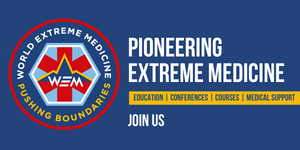Mark Haase / Flight Nurse
Mark Haase is an experienced Flight Nurse with the California Shock Trauma Air Rescue, and gives us a little insight into an average shift high above Lake Tahoe.
09:40
A banana, two yoghurts and a couple of tangerines at the grocery store. I have 5 minutes to make report from the off-duty crew. The basic food groups for a Saturday shift as a Flight Nurse (FN) may be predictable, but the course of the 24 hour shift is anything but.
I have spent 17 years in HEMS (helicopter emergency medical services), 12 with CALSTAR (California Shock Trauma Air Rescue), and today’s shift is like many others. We meet the previous crew, discuss their prior calls, and exchange hand-held radios, pagers and computers chocked full of policies and procedures. The FNs already know many of the procedures by memory, but having a guide in your hand sure does make me feel better for some reason! Once completed, I carefully hang my helmet upside down by the left hook on the wall. In the bottom of the helmet sit my ear-buds for noise protection. Fire resistant gloves follow, and a wool cap on top. On the shelf above sit my NVGs (night vision goggles) with the strap tucked cleanly away. I don’t know where all these punctilious habits have formed, but they work for me.
10:00
The cacophony of ubiquitous sounds start. First, the handheld radios come to life with voices making sure I heard them. “Loud and clear” I reply. Cell phones and pagers are to follow. They too get replies of confirmation. I already have a sense of how the day will unfold by listening to the dispatcher’s voice: quick to tongue, edgy, and full of detail. Yes, today will be busy.
As always, a pre-flight is required. Monitors checked, IV pump charged, medications changed and ventilator functional. Lastly, a debriefing with the pilot to check weather, aircraft status and any operational issues.
11:00
We are in full March weather conditions, and the ski lift chairs are in full swing at the local resorts. The Lake Tahoe area is full of weekend warriors ready to shred the hills. Our first 911 call comes in. “CALSTAR 6, scene call to Heavenly Ski Resort. Unconscious male. Tree strike”. Within 5 minutes we’re airborne and on the radio to Ski Patrol. 5 minutes later we are overhead assessing the landing zone. My FN partner has already set up all the medications for a rapid sequence intubation (RSI), turned on the monitor and set up the end tidal CO2 wave form. We’re planning on a 90kg weight, but we can adapt based on patient presentation. Once landing at 9000 feet, we do a quick primary assessment and in 5 minutes are back in the helicopter; it’s just far too cold outside to do any more than that. Within minutes we set up an IV, RSI and intubate the 26 year old snowboarder who collided with a tree. I now have about 15 minutes to the level II trauma center. By the time I give report to the team and un-package our patient, snow from the snowboarder’s boots falls to the ground. Now that’s rapid transport!
After a quick post-flight debrief on the rooftop of the hospital, the pilot calls “clear” and the twin engines wind to life. I do a quick walk-around to ensure all cowling are closed and no oil is leaking. We depart with a dead-leg lasting 20 minutes.
As we all know, anything worthwhile requires paperwork. This patient contact is no different. I am one of those hunt-and-peck keyboard persons, so subsequently my charts take about 1 and a half hours. 9 pages later I am done! A quick review by my partner and the chart is sent off to the digital world.
00:00
“I had a sneaky suspicion”, my partner chimes. Once again the radio dispatches us for an inter-facility at midnight. This time the patient is a 67 year old female with a STEMI (ST segment elevation myocardial infarction). I have learned great respect for 12-lead interpretation; this one showed substantial ST elevation in the posterior leads. No time for delay, our in-house time was 4 minutes! I knew I had a 12 minute flight to the interventional cardiology unit. She lived without any deficits despite arresting twice in flight, needing cardioversion 3 times and 8 minutes of CPR.
08:00
One more call in the early morning rounds-out my 24 hour shift. I turn to domestic chores. Scrub the toilet. Yes, that’s my job. Toss the trash and swirl the vacuum around to pick up all the popcorn debris from downtime. Yes! The new crew is here, and it’s my time for giving report. Now to head out and go for a quick mountain bike ride, as I am back tomorrow for another 24 hours. I love my job.






